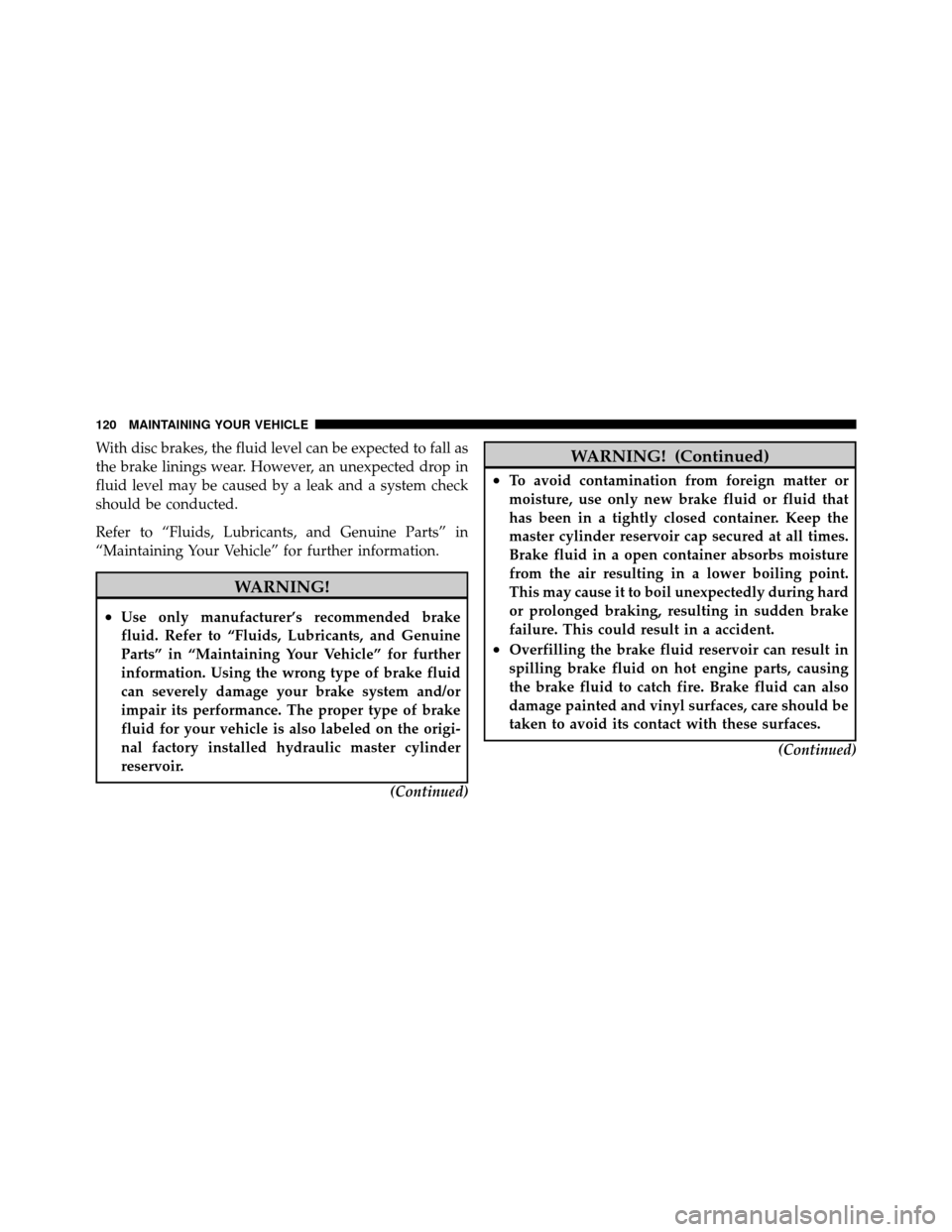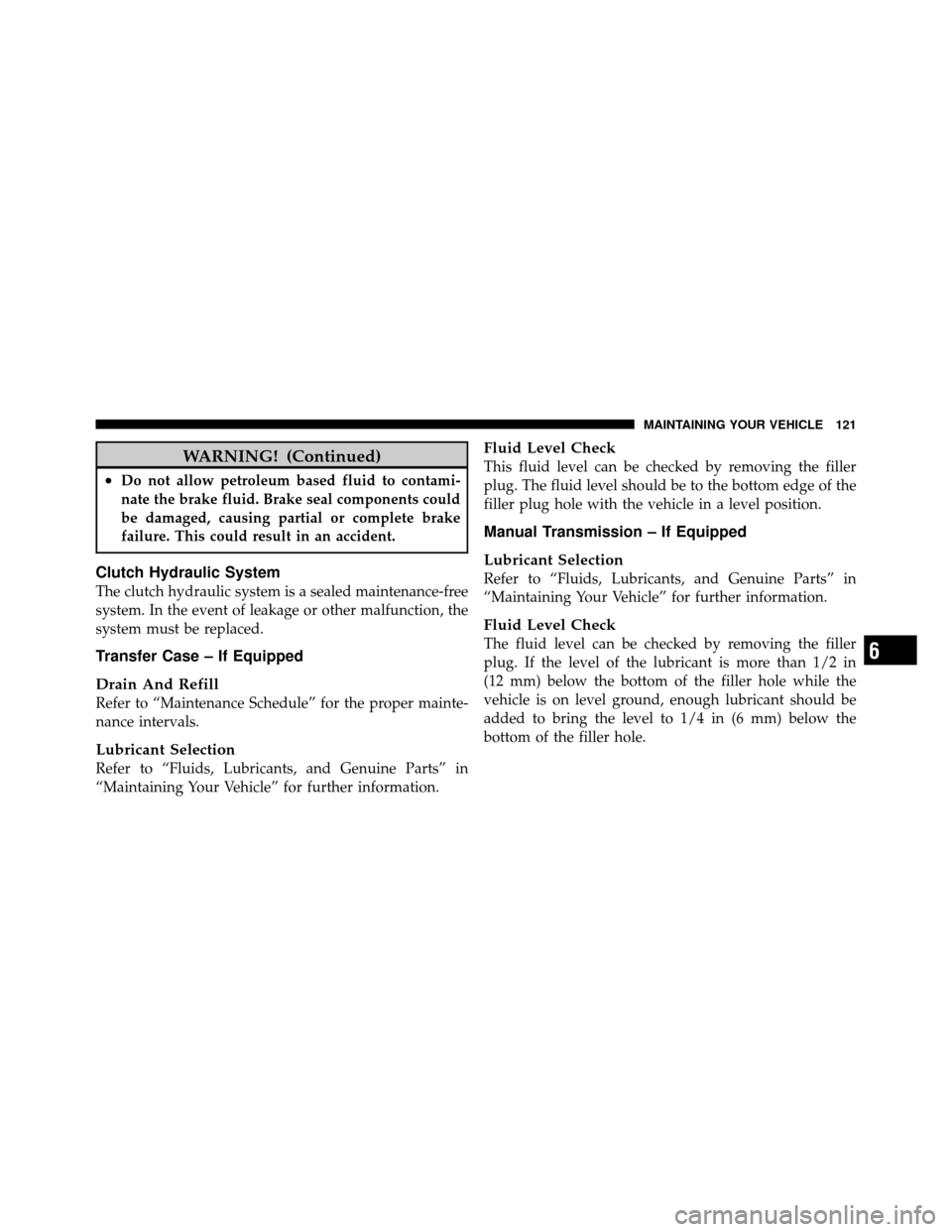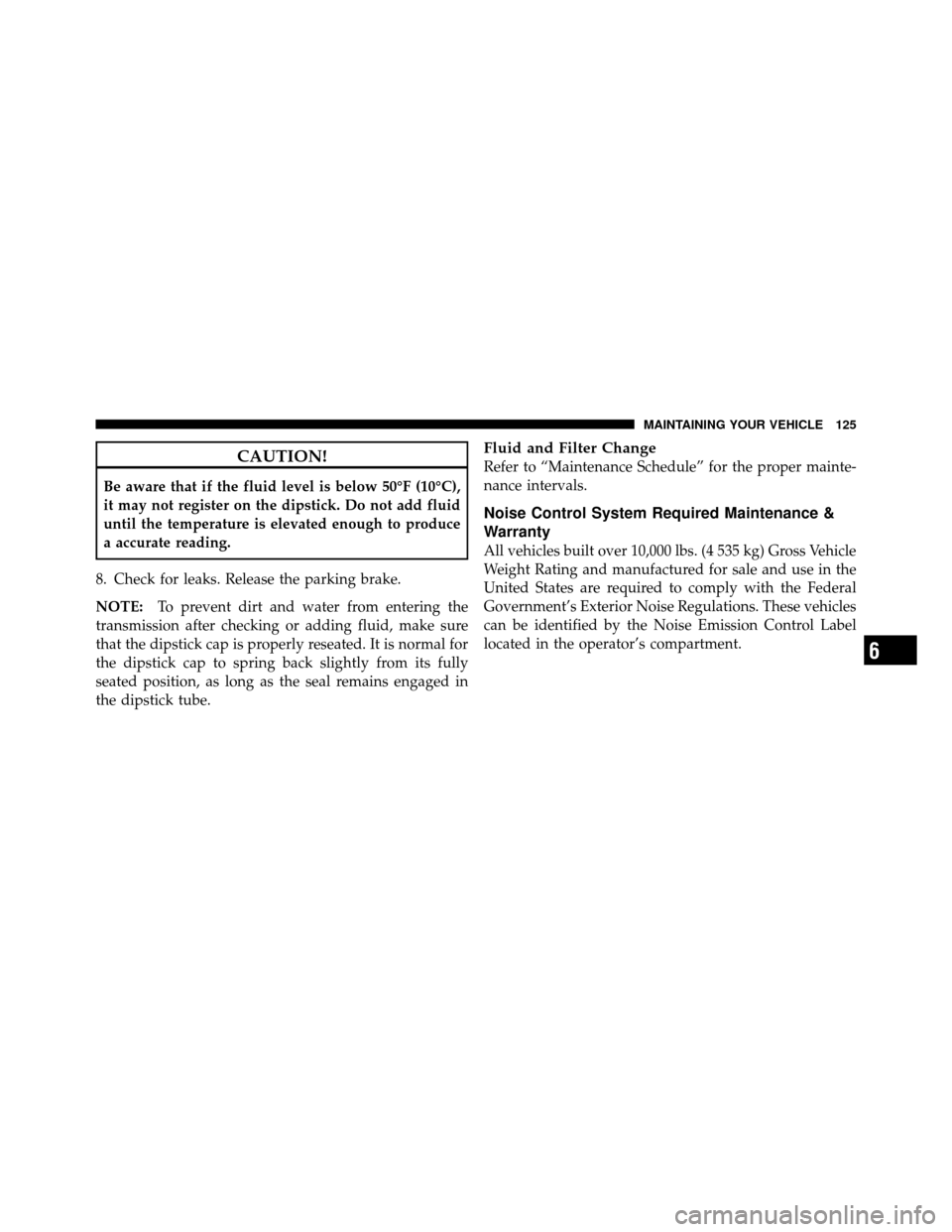Page 98 of 170
ENGINE COMPARTMENT — 6.7L DIESEL
1 — Battery7 — Engine Oil Dipstick
2 — Engine Coolant Reservoir 8 — Washer Fluid Reservoir
3 — Automatic Transmission Dipstick (If Equipped) 9 — Engine Oil Fill
4 — Brake Fluid Reservoir 10 — Coolant Pressure Cap
5 — Clutch Master Cylinder (Manual Transmission Only) 11 — Air Cleaner Filter
6 — Integrated Power Module
6
MAINTAINING YOUR VEHICLE 97
Page 120 of 170

•Keep the front of the radiator clean. If your vehicle is
equipped with air conditioning, keep the front of the
condenser clean.
•Do not change the thermostat for Summer or Winter
operation. If replacement is ever necessary, install
ONLY the correct type thermostat. Other designs may
result in unsatisfactory cooling performance, poor gas
mileage, and increased emissions.
Charge Air Cooler – Inter-Cooler
The charge air cooler is positioned between the radiator
and the air conditioner condenser. Air enters the engine
through the air cleaner and passes through the turbo-
charger, where it is pressurized. This pressurized air
rapidly reaches high temperature. The air is then directed
through a hose to the charge air cooler and through
another hose to the intake manifold of the engine. The air
entering the engine has been cooled by about 50° to 100°F
(10° to 38°C). This cooling process enables more efficient
burning of fuel resulting in fewer emissions.To guarantee optimum performance of the system, keep
the surfaces of the charge air cooler, condenser and
radiator clean and free of debris. Periodically check the
hoses leading to and from the charge air cooler for cracks
or loose clamps resulting in loss of pressure and reduced
engine performance.
Brake System
Brake Master Cylinder – Brake Fluid Level Check
The fluid level of the master cylinder should be checked
when performing under the hood service, or immedi-
ately if the “Brake System Warning Light” indicates
system failure.
The brake master cylinder has a translucent plastic
reservoir. On the outboard side of the reservoir, there is a
“MAX” mark and an “MIN” mark. The fluid level must
be kept within these two marks. Do not add fluid above
the full mark because leakage may occur at the cap.
6
MAINTAINING YOUR VEHICLE 119
Page 121 of 170

With disc brakes, the fluid level can be expected to fall as
the brake linings wear. However, an unexpected drop in
fluid level may be caused by a leak and a system check
should be conducted.
Refer to “Fluids, Lubricants, and Genuine Parts” in
“Maintaining Your Vehicle” for further information.
WARNING!
•Use only manufacturer’s recommended brake
fluid. Refer to “Fluids, Lubricants, and Genuine
Parts” in “Maintaining Your Vehicle” for further
information. Using the wrong type of brake fluid
can severely damage your brake system and/or
impair its performance. The proper type of brake
fluid for your vehicle is also labeled on the origi-
nal factory installed hydraulic master cylinder
reservoir.(Continued)
WARNING! (Continued)
•To avoid contamination from foreign matter or
moisture, use only new brake fluid or fluid that
has been in a tightly closed container. Keep the
master cylinder reservoir cap secured at all times.
Brake fluid in a open container absorbs moisture
from the air resulting in a lower boiling point.
This may cause it to boil unexpectedly during hard
or prolonged braking, resulting in sudden brake
failure. This could result in a accident.
•Overfilling the brake fluid reservoir can result in
spilling brake fluid on hot engine parts, causing
the brake fluid to catch fire. Brake fluid can also
damage painted and vinyl surfaces, care should be
taken to avoid its contact with these surfaces.(Continued)
120 MAINTAINING YOUR VEHICLE
Page 122 of 170

WARNING! (Continued)
•Do not allow petroleum based fluid to contami-
nate the brake fluid. Brake seal components could
be damaged, causing partial or complete brake
failure. This could result in an accident.
Clutch Hydraulic System
The clutch hydraulic system is a sealed maintenance-free
system. In the event of leakage or other malfunction, the
system must be replaced.
Transfer Case – If Equipped
Drain And Refill
Refer to “Maintenance Schedule” for the proper mainte-
nance intervals.
Lubricant Selection
Refer to “Fluids, Lubricants, and Genuine Parts” in
“Maintaining Your Vehicle” for further information.
Fluid Level Check
This fluid level can be checked by removing the filler
plug. The fluid level should be to the bottom edge of the
filler plug hole with the vehicle in a level position.
Manual Transmission – If Equipped
Lubricant Selection
Refer to “Fluids, Lubricants, and Genuine Parts” in
“Maintaining Your Vehicle” for further information.
Fluid Level Check
The fluid level can be checked by removing the filler
plug. If the level of the lubricant is more than 1/2 in
(12 mm) below the bottom of the filler hole while the
vehicle is on level ground, enough lubricant should be
added to bring the level to 1/4 in (6 mm) below the
bottom of the filler hole.6
MAINTAINING YOUR VEHICLE 121
Page 123 of 170

Automatic Transmission – If Equipped
Lubricant Selection
Refer to “Fluids, Lubricants, and Genuine Parts” in
“Maintaining Your Vehicle” for further information.
Fluid Level Check – 68RFE (Ram Truck Only)
If your vehicle is equipped with a dipstick, use the
following procedure. If your vehicle has a capped dip-
stick tube, it is sealed and should not be tampered with.
Your authorized dealer has the proper tools to ensure that
the fluid level is set properly. The fluid level should be
checked when the engine is fully warmed up and the
fluid in the transmission is at normal operating tempera-
ture. Operation of the transmission with an improper
fluid level will greatly reduce the life of the transmission
and of the fluid. Check the fluid level whenever the
vehicle is serviced.
To properly check the automatic transmission fluid level,
the following procedure must be used:1. Operate the engine at idle speed and normal operating
temperature.
2. The vehicle must be on level ground.
3. Fully apply the parking brake and press the brake
pedal.
4. Place the shift lever momentarily into each gear posi-
tion ending with the shift lever in PARK.
5. Remove the dipstick, wipe it clean and reinsert it until
seated.
6. Remove the dipstick again and note the fluid level on
both sides. The fluid level should be between the “HOT”
(upper) reference holes on the dipstick at normal operat-
ing temperature. Verify that solid coating of oil is seen on
both sides of the dipstick. If the fluid is low, add as
required into the dipstick tube.
Do not overfill.After
adding any quantity of oil through the oil fill tube, wait
a minimum of two minutes for the oil to fully drain into
the transmission before rechecking the fluid level.
122 MAINTAINING YOUR VEHICLE
Page 124 of 170

NOTE:If it is necessary to check the transmission below
the operating temperature, the fluid level should be
between the two “COLD” (lower) holes on the dipstick
with the fluid at approximately 70°F (21°C) (room tem-
perature). If the fluid level is correctly established at
room temperature, it should be between the “HOT”
(upper) reference holes when the transmission reaches
180°F (82°C). Remember it is best to check the level at the
normal operating temperature.
CAUTION!
Be aware that if the fluid temperature is below 50°F
(10°C) it may not register on the dipstick. Do not add
fluid until the temperature is elevated enough to
produce an accurate reading.
7. Check for leaks. Release parking brake. To prevent dirt and water from entering the transmission
after checking or replenishing fluid, make certain that the
dipstick cap is properly reseated. It is normal for the
dipstick cap to spring back slightly from its fully seated
position, as long as its seal remains engaged in the
dipstick tube.
Fluid Level Check – AS68RC (Chassis Cab Only)
Check the fluid level while the transmission is at normal
operating temperature. This occurs after at least 15 miles
(25 km) of driving. At normal operating temperature, the
fluid cannot be held comfortably between the fingertips.
To properly check the transmission fluid, the following
procedure must be used.
1. The vehicle must be on level ground.
2. Operate the engine at idle speed for a minimum of
60 seconds and normal operating temperature.
6
MAINTAINING YOUR VEHICLE 123
Page 125 of 170

3. Fully apply the parking brake and press the brake
pedal.
4. Place the shift lever momentarily into each gear posi-
tion ending with the shift lever in PARK. Make sure the
engine is running at idle speed.
5. Remove the dipstick and determine if the fluid is hot
or cold. Hot fluid is approximately 160°F to 175°F (70°C
to 82°C). This is the normal operating temperature after
the vehicle has been driven at least 15 miles (25 km). The
fluid cannot be comfortably held between the fingertips.
Only use the cold region of the dipstick as a rough
reference when doing initial oil level set after transmis-
sion rebuild or transmission refill.
6. Wipe the dipstick clean and reinsert it until seated.
7. Remove the dipstick again and note the fluid level on
both sides. The fluid level should be between the HOT(upper) reference holes on the dipstick at normal operat-
ing temperature. Verify that a solid coating of oil is seen
on both sides of the dipstick. If the fluid is low, add
MOPAR�
AS68RC Automatic Transmission Fluid or
equivalent as required into the dipstick tube. Do not
overfill. Never use any ATF other than MOPAR�
AS68RC Automatic Transmission Fluid or equivalent.
After adding any quantity of oil through the dipstick
tube, wait a minimum of two minutes for the oil to fully
drain into the transmission before rechecking the fluid
level.
NOTE: If it is necessary to check the transmission below
the operating temperature, the fluid level should be
between the two COLD (lower) holes on the dipstick
with the fluid at approximately 70°F to 85°F (20°C to
30°C). If the fluid level is correctly established at room
temperature, it should be between the HOT (upper)
reference holes when the transmission reaches 160°F to
175°F (70°C to 82°C).
124 MAINTAINING YOUR VEHICLE
Page 126 of 170

CAUTION!
Be aware that if the fluid level is below 50°F (10°C),
it may not register on the dipstick. Do not add fluid
until the temperature is elevated enough to produce
a accurate reading.
8. Check for leaks. Release the parking brake.
NOTE: To prevent dirt and water from entering the
transmission after checking or adding fluid, make sure
that the dipstick cap is properly reseated. It is normal for
the dipstick cap to spring back slightly from its fully
seated position, as long as the seal remains engaged in
the dipstick tube.
Fluid and Filter Change
Refer to “Maintenance Schedule” for the proper mainte-
nance intervals.
Noise Control System Required Maintenance &
Warranty
All vehicles built over 10,000 lbs. (4 535 kg) Gross Vehicle
Weight Rating and manufactured for sale and use in the
United States are required to comply with the Federal
Government’s Exterior Noise Regulations. These vehicles
can be identified by the Noise Emission Control Label
located in the operator’s compartment.
6
MAINTAINING YOUR VEHICLE 125